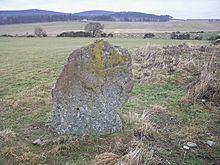|
|
|
|
WaulkmillStanding Stone / Menhir
|
||||||||||||||||||||||||
|
|
|
Images (click to view fullsize) |
|









|
Fieldnotes |
|
|
A recent excavation at Waulkmill produced quite a variety of finds from Neolithic to Iron Age . Pics are of ,a ring cairn probably central to the original stone circle . Bronze Age decorated pottery (in finds tray ) .There was also a sherd of Neolithic carinated bowl . Cremated bone just outside the area of the stone circle . The reason for the standing stone pic ,from the same spot as Drewbhoys is that this one shows some of the packing i.e. a tyre . The stone had been moved from it's previous site , which was unlikely to have the original site either . |
 Posted by tiompan
Posted by tiompan27th September 2012ce |
|
Tarland is situated on the B9119 and in its centre is Meglum Road. Follow this road out of the village and take the farm track to the left. The standing stone is the sole survivor of a RSC and can be found about a 1/4 mile up the track next to the road. Slightly further along is a cairn and the remnants at Meglum. Visited 11/10/08. |
15th June 2009ce |
Folklore |
|
|
This lone 5'8" stone is said to have once been part of a stone circle. The other 10 or 11 stones were removed c.1835, according to the 1905 source mentioned in the Canmore record. It was also said that the surviving stone originally had projections from two edges so that it resembled a cross. They were supposedly knocked off when the circle was destroyed. This tradition was collected in the 1930s (and was still known in the late 60s) - it seems quite a strange idea? The stone does have a kind of 'waist'. You can see a picture of it from 1904 at http://www.rcahms.gov.uk/pls/portal/newcanmore.p_coll_details?p_arcnumlink=680007 |
 Posted by Rhiannon
Posted by Rhiannon1st July 2005ce |

